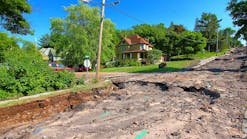About the author:
Doug Coenen is principal and senior project manager in Walter P Moore’s Civil Engineering Group. He can be reached at [email protected]. Ray Drexler is principal and senior project Manager in Walter P Moore Diagnostics. He can be reached at [email protected].
Doug Coenen & Ray Drexler
undefinedFlood protection is the effort to reduce loss of life and property by lessening the impact of disasters, according to the Federal Emergency Management Agency (FEMA). Effective flood protection requires understanding local and larger risks, addressing difficult choices, and investing in long-term community well-being. Without sound flood protection action as it relates to a structure, the safety, financial security and self-reliance of the structure may be jeopardized.
Five key factors to an effective flood protection system include:
- Affordability
- Reducing future flooding disruptions
- Allowing facility operations during most extreme events
- Construction without significantly impacting facility operations
- Operating easily with minimal maintenance
Five consultant qualifications clients should consider when hiring a consultant to design a flood protection system include:
- Demonstrated experience with FEMA oversight flood protection design and successful implementation;
- Deep federal floodplain construction code and requirement knowledge;
- Understanding the interactions and co-dependencies of the various project architectural, civil, MEP and structural requirements;
- Ability to educate client staff on flood protection systems operation and maintenance and;
- Ability to develop operational protocols for optimal system performance
Flood Protection Basis
Flood protection projects should start with developing site-specific risk definitions. Knowledge of hydrology, stream hydraulics and site topography define the potential flood elevations and the associated risk(s) to the improvements and operations of the facility. Structural and building enclosure knowledge determines likely leak and collapse points that may impact the facility improvements and operations considering architectural and/or mechanical, electrical, and plumbing (MEP) features. Modifying architectural and MEP features can be difficult because existing features are required for various reasons; the team must understand all the interdependencies to successful design and implement flood protection. This common understanding of risk forms the basis of the design decision-making. The client’s direction on risk, cost and reward are then used to establish the design basis parameters.
Flood Protection Approach
The client should understand the differing costs and risks associated between active and passive flood protection. Passive flood protection minimizes the need for human interaction to engage the protection measures, however, this is not always feasible. While active flood protection may have lower costs, it typically requires human intervention to deploy the system. Experience indicates many active flood protection systems “fail” simply because they are not deployed in time or not completely deployed due to operator absence or error.
Alternatively, wet flood protection projects involve applying measures that prevent or provide resistance to damage from flooding by allowing floodwaters to enter the facility. Minimal cleanup is normally required before resuming operations; this is more typically applied to structures, such as parking garages.
Flood Protection Selection
The solution is the collaboration between the architect; civil, structural and MEP engineers; and the client’s personnel to establish protection and risk expectations. In many cases with existing buildings, the codes governing the improvements are not well defined. The team collaborates with the vendors of flood protection products to find workable solutions, often working with them to create specific attributes for the unique conditions that exist at the property and then working with code officials to resolve ambiguities. The solution must meet specific parameters defined by FEMA and local Emergency Management Agencies when they are providing a portion of the funding for the project.
Proactive clients address flood risks by assembling a cohesive team that understands the specific flooding concerns of the facility to be protected to deliver a well thought out and properly executed project.
The six basic steps of a successful project follow:
- Scoping: The initial phase is a feasibility study or scoping to set the project parameters.
- Assessment: The second phase, facility assessment, forms the basis of what is and is not feasible or practical in terms of flood protection options with respect to constructability and finances. The assessment needs to determine the appropriate level of flood protection required.
- Design: Flood protection design is site specific and is examined here in very broad terms. The engineers drive the flood protection system requirements and designs. Meanwhile, the architect guides the aesthetic elements focusing on the appearance of the finished product while the team maintains constructability and functionality.
- Bidding: Contractors should list previous flood protection projects and contacts to prove prior work and historical performance. A pre-bid site walk with all potential bidders and providers of significant pre-engineered components, such as flood gates/doors, is strongly encouraged so all parties understand the intention, constraints and specific requirements. The design team is often active in the bid tabulation and selection of manufacturers and contractor(s).
- Construction: Visits are required at appropriate intervals for the team to become familiar with the progress and quality of the work and to determine if the work is being performed in a manner indicating that construction, when completed, will be in accordance with the contract documents. Retrofit flood protection projects require more frequent construction visits to ensure the new and existing constructions are properly connected.
- Maintenance: After construction, a written operational protocol that addresses how to operate the flood protection system should be developed to provide the necessary understanding and documentation for deployment of the system. The documentation serves as a guide to train future staff and is a critical reference before and during a storm event. The end of construction is the beginning of the flood protection system life. Staff should train and maintain the system on a semi-annual to quarterly basis. Documentation addressing system maintenance, testing, and operations must be developed by the design team in consultation with the client’s staff to establish future protocols and responsibilities.
Flood protection projects range from new projects to expansions and retrofits, generally including commissioning testing to prove the system integrity before final delivery.






